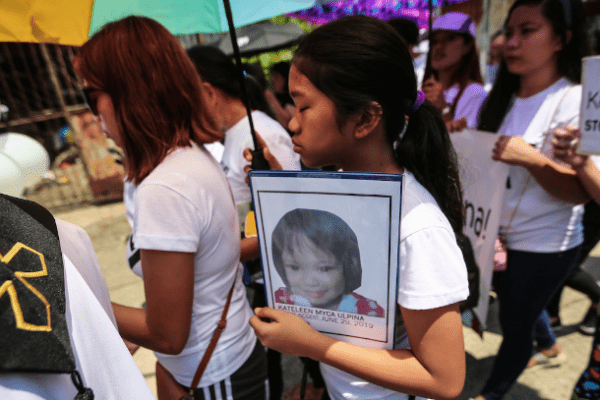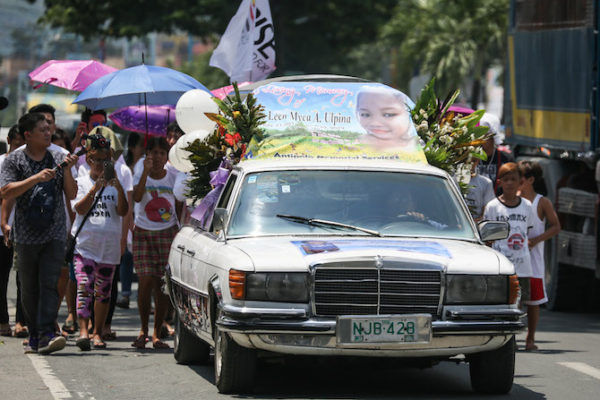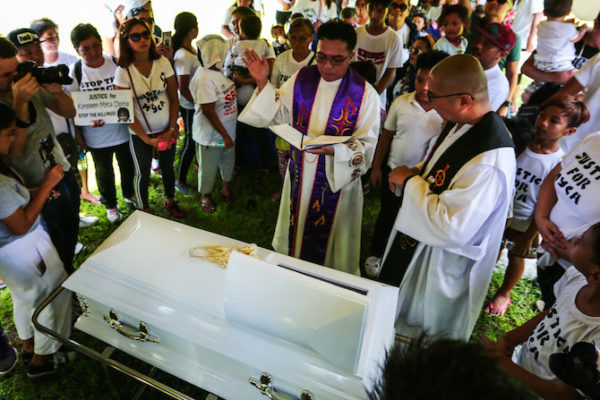When 3-year-old girls become ‘collateral damage’
August 9, 2019 · By Marielle Lucenio, Manila for www.ucanews.com

Friends and relatives of Myca, the three-year Filipino old girl shot dead during a police anti-narcotics operation, attend her funeral on the outskirts of Manila on July 9. (Photo by Jire Carreon)
It was just past six o’clock in the morning when the armed men came. They had their faces covered, but those inside the house knew the intruders were policemen.
The masked men shattered windows and kicked the doors open while shouting for “Kato” (not his real name) to surrender.
“Kato” was a “drug suspect,” one of those included on a list prepared by community leaders of alleged drug users and dealers in the area. He was still asleep with his family when the policemen came.
In a police report filed later, “Kato” reportedly tried to escape via the roof with his 3-year-old daughter, Myca, as a “human shield.”
Myca’s mother, however, said it was “impossible” for “Kato” to use his child to try to ward off the policemen.
“He loved his daughter very much. He would never do that,” she said.
The woman said it was only when “Kato” saw that his daughter was shot that he came back and shot it out with the police.

A hearse carrying the body of 3-year-old Myca, heads to a cemetery for her funeral in Manila on July 9. (Photo by Jire Carreon)
A week after the crying
It was a gloomy Tuesday afternoon a week after the young Myca was laid to rest. The day came with ineffable emptiness.
Children surrounded a blue jeep parked outside the family home, giddily checking on a bike, dolls, and plastic cabinets inside.
The verve shifted on to remembering as boxes were brought down from the house.
The children started arguing about which box their beloved Myca used to insert her tiny 3-year-old self in.
Less than two weeks after the Myca’s death, much has already changed in the lives of people who were close to the slain girl.
Her mother, Liza, for one, had a different hair color as her blond hair was already “overexposed” because of media interviews.
The family had also changed address, and some routines, but not the narrative they tell about the day the young girl died.
Death gave a warning before its arrival through the sound of shattered windows.
It was early on June 29, Liza recalled, when the sound of breaking glass woke her. She went down to check, thinking it might be some early visitors.
“What’s that? Who’s in there?” she shouted.
The crashing continued. Liza went up to the bedroom, scared. She woke her husband and asked him to check on what was happening downstairs.
“Ma, this seems like a raid,” said “Kato,” a former officer in the police’s Criminal Investigation and Detection group.
Liza peeked through the glass window and saw a man with a gun.
The stranger was wearing a cap, a black jacket over a white shirt, a mask on his face. Only a pair of black eyes was visible, a pair of eyes Liza said she would never forget.
Her husband opened the bedroom window and went out.
“He was supposed to escape,” said Liza, adding the “Kato” did not want his family to get involved in what would happen. “But the child followed him. They were scared,” she recalled.
The door was forced open. The armed men entered the room. The next thing Liza saw was a gun pointed at her.
“A child followed him. My husband has a child with him,” she told the armed men as a warning.
They went after “Kato” through the door to the roof. Liza fled outside the house. She heard a gunshot.
“F*#k you, you shot my child!” Liza heard her husband yell. Then more gunshots.
Myca fell from the roof with her lifeless father who was later found to have been shot four times — one to the stomach, one to an arm, and two to his head.
Myca was still alive and was taken to a hospital where she died the next day after having been shot in the head, foot, and hand.
A police officer also died during the exchange of gunfire.Myca’s dream killed her
While police claimed that Myca was used as a “human shield,” Liza said it was impossible.
“How can that be? She was her papa’s favorite. He could never do that to her,” the woman said.
Of the seven children, four from the husband’s first wife, only Myca took after her father’s build and looks, said Liza.
The young girl dreamt of becoming a police officer like her father. A photo of the girl wearing a police uniform was displayed during her wake.
“Little did I know, it was also the police who would kill my own daughter,” said Liza. “Her own dream killed her.”
Myca was one of many children who fell victim to the government’s war against drugs, which has so far killed about 6,000 people, according to authorities.
Liza said there was no drug transaction going on that morning her husband and child were killed.
“Have you seen the photos of my husband? He was just wearing boxer shorts. Why would he go to a ‘transaction’ in thin boxers?” she said. “There was no buy-bust operation.”
The police claimed otherwise.
Myca, a 3-year-old girl killed with her father during a police anti-narcotics operation, is laid to rest on July 9. (Photo by Jire Carreon) Apologies to ‘collateral damage’
Catholic priest, Father Flavie Villanueva, who has been very outspoken against the drug war killings, said that in all such killings since 2016 “nobody fought back.”
“I’m sorry, Myca, because you lived in a time when killing is normal. Sorry if you were called ‘collateral damage,'” said the priest in his homily during Myca’s funeral.
One evening, as Liza was preparing dinner, she called for Myca until she realized that her daughter was now gone.
She said she and the other children would eventually have to settle somewhere, in another place where they can feel safe.
Liza said it doesn’t mean she’s backing out from filing a case against the police. She said she will do so after July 30, when Myca would have turned 4 years old.
Despite the deaths and the cries of indignation, the killings continue, says Jose Noel Olano, director of Amnesty International in the Philippines.
The rights organization released a report on July 10 on the “ongoing extrajudicial executions and other violations in the Philippines’ drug war.”
“As if it has become normal,” said Olano. “It seems that we are being conditioned to accept that the killings have become normal.”
The U.N. High Commissioner for Human Rights noted that according to various reports up to 27,000 people might have been killed in the Philippines’ campaign against illegal drugs.
It said Philippine President Rodrigo Duterte seems to continue to “explicitly encourage” the killings.
In June, the scale and seriousness of the reported human rights violations prompted U.N. human rights experts to call on the world body’s rights council to establish an independent investigation into such violations.
The proposed resolution was approved but was questioned by the Philippine government.
Amnesty International warned that the “extrajudicial executions” amount to crimes against humanity.
Police claimed there was surveillance done on their target, “Kato.” But if they did, then they should have realized that there were innocent people, including children, in the house.
Something was not followed, or something went wrong in police operational procedures, resulting in Myca’s death.
As stories came out in the media about the death of the young girl, former national police chief, now senator, Ronald dela Rosa, said “collateral damage” in police operations is inevitable.
“Shit happens,” he said.
Vincent Go contributed to this report.







